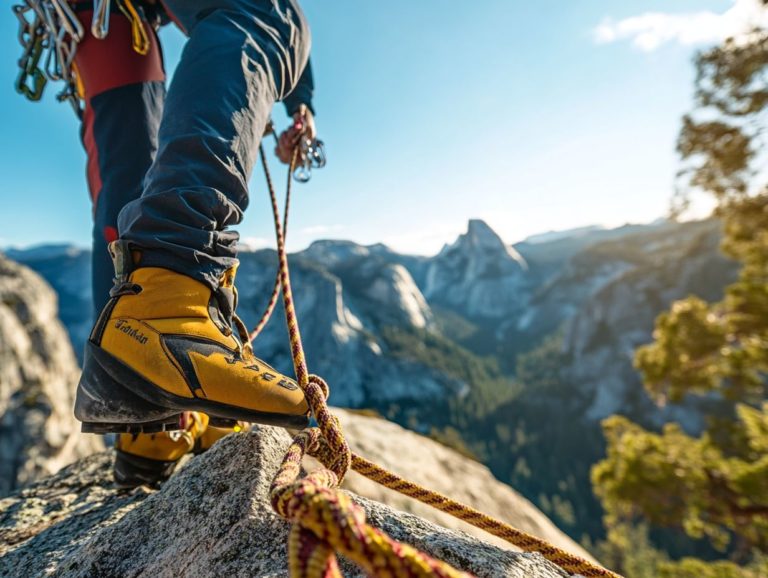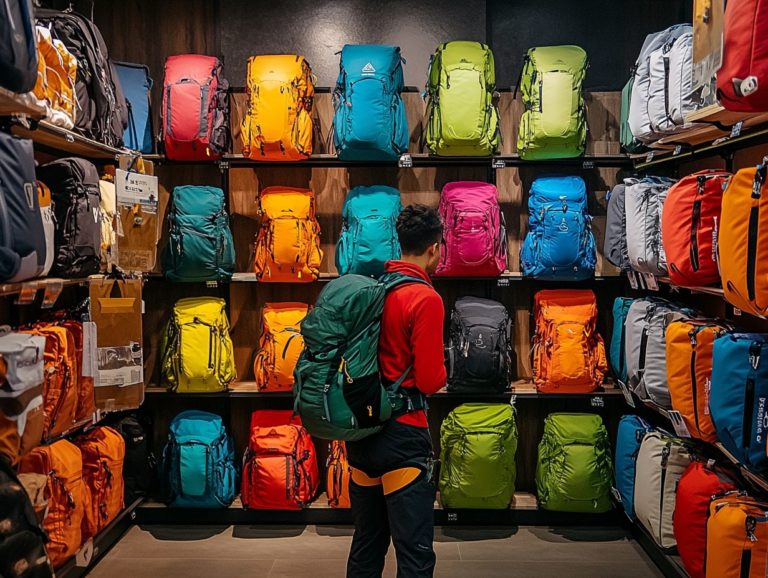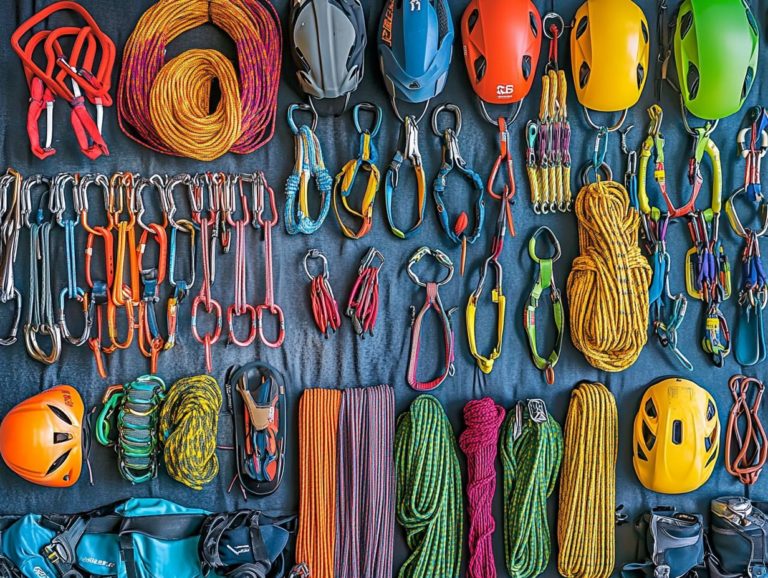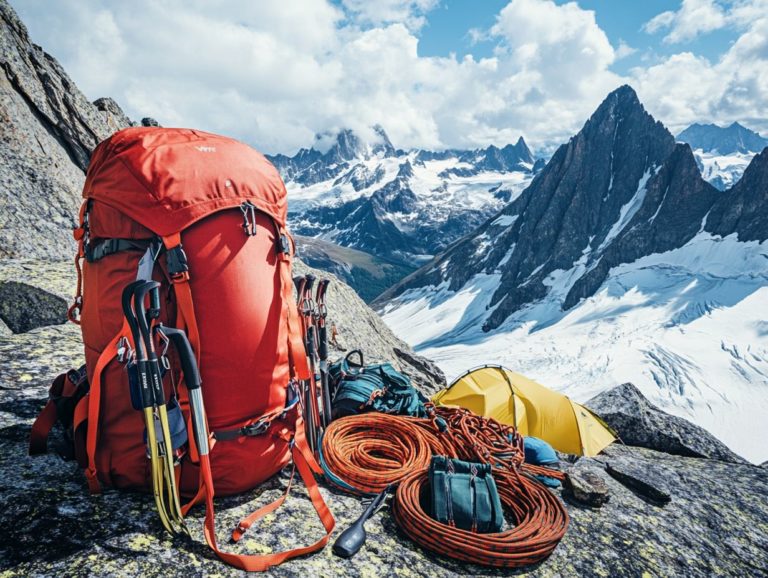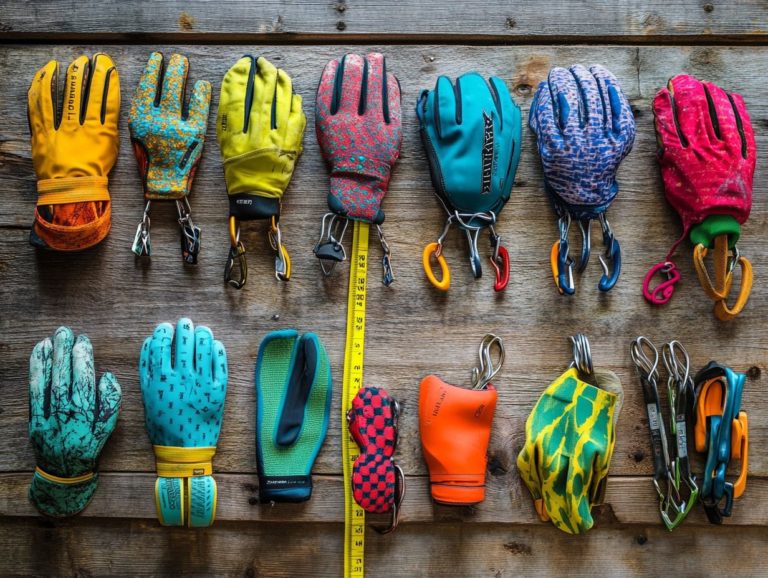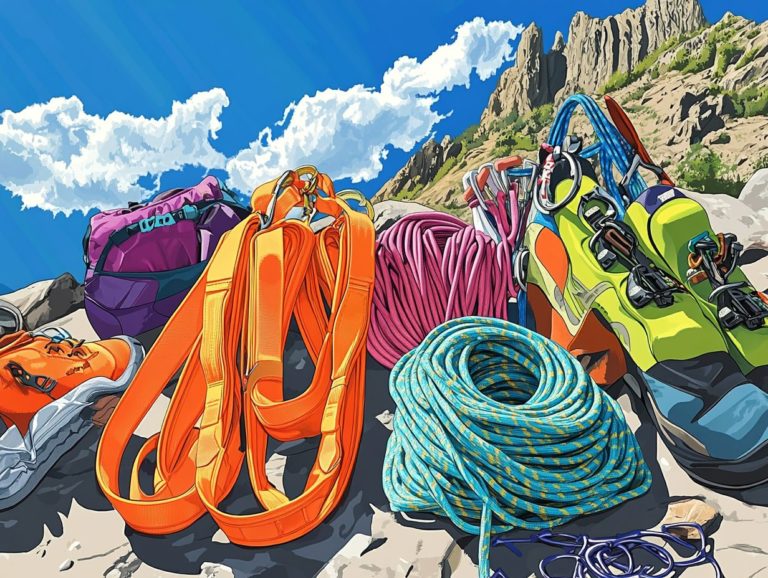Choosing the Right Climbing Gear for Beginners
Getting into climbing can be an exhilarating journey, but having the right gear is crucial for both your safety and enjoyment. Don t wait to start your adventure!
This guide will meticulously break down the essential equipment every beginner should consider, from climbing shoes to harnesses. You ll be fully prepared for your first ascent.
If you re eager to elevate your skills, we ll also explore additional gear like ropes and quickdraws. You ll need to weigh key factors when selecting your gear.
This will help you make informed choices that align with your climbing style and budget. Dive in to uncover everything you need to gear up for your climbing adventures!
Contents
- Key Takeaways:
- Understanding the Basics
- Essential Gear for Beginners
- Harness
- Chalk Bag
- Belay Device
- Helmet
- Additional Gear for Advanced Climbing
- Factors to Consider When Choosing Gear
- Frequently Asked Questions
- What is the most important piece of gear for beginners when starting to climb?
- What type of harness should beginners use for climbing?
- Is a helmet necessary for beginner climbers?
- What type of rope should beginners use when climbing?
- How should beginners choose the right climbing shoes?
- What other essential gear should beginners have when starting to climb?
Key Takeaways:
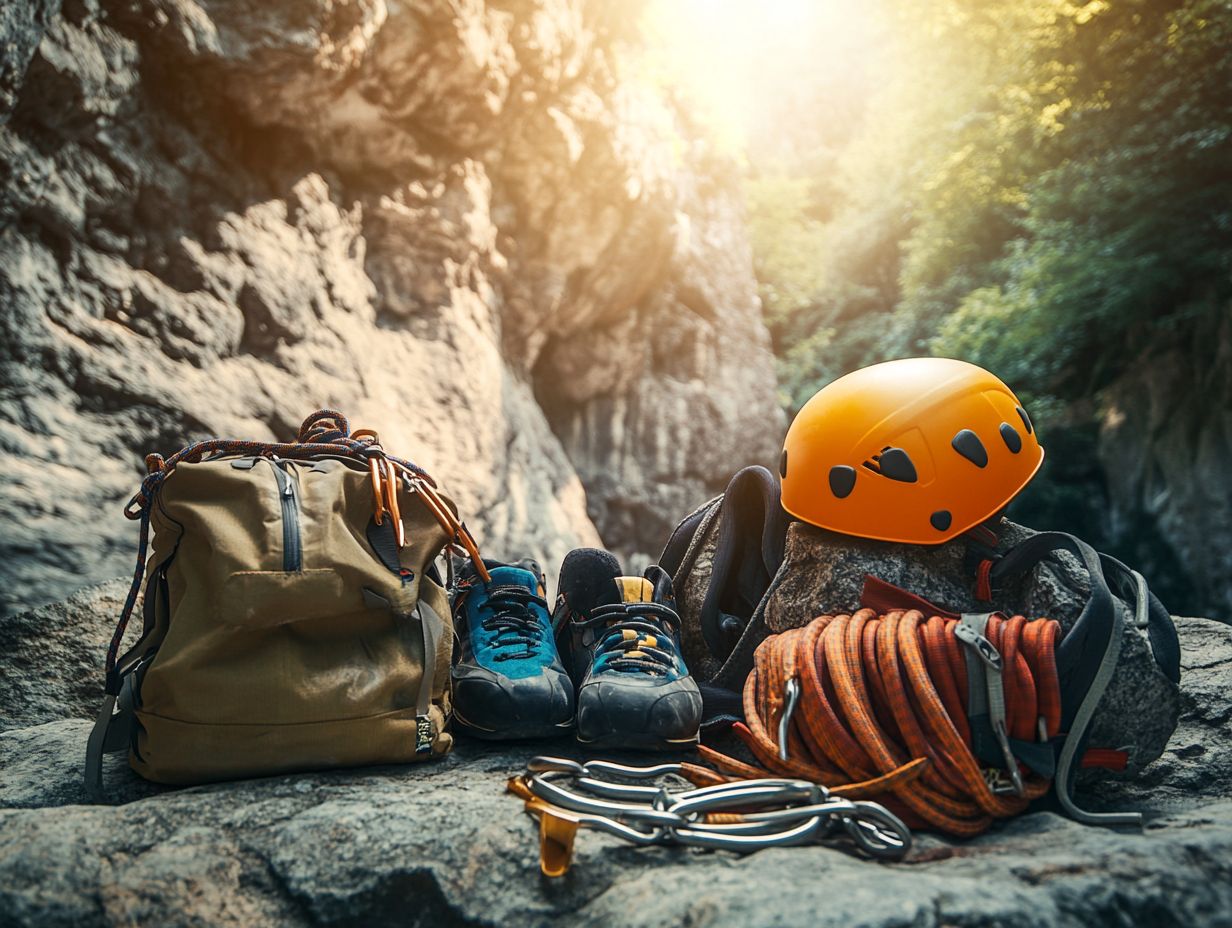
- Choose quality gear that fits well and is within your budget.
- For beginners, essential gear includes climbing shoes, harness, chalk bag, belay device (used to control the rope for safety), and helmet.
- Factors to consider when choosing gear include fit, comfort, price, brand, and quality.
Understanding the Basics
Grasping the fundamentals of climbing is essential for anyone eager to embark on this exhilarating journey. This is particularly true for beginners keen to explore both outdoor and indoor climbing environments.
This initial phase emphasizes vital climbing techniques, safety protocols, and the core essence of the climbing experience. You ll be well-prepared to face the challenges ahead.
Kick off your climbing adventure at a climbing gym where excitement awaits! You’ll familiarize yourself with essential gear, including climbing shoes, climbing harnesses, and belay devices crucial elements for both safety and performance in all types of rock climbing.
Essential Gear for Beginners
As you embark on your climbing journey, securing the right gear is paramount for a safe and enjoyable experience. Essential items like climbing shoes, harnesses, helmets, and belay devices form the cornerstone of your climbing arsenal.
These items give you the power to cultivate both confidence and skill. Investing in chalk bags and climbing apparel elevates your performance by offering grip and comfort, allowing you to concentrate on honing your techniques and personal style.
Don’t forget to consider a climbing pack to carry your gear. The right accessories can make a significant difference in your climbing experience.
Climbing Shoes
Climbing shoes are among the most essential pieces of equipment for any climber. They directly influence your ability to execute climbing techniques with finesse.
Designed for a snug fit and superior grip, these shoes allow you to truly connect with the rock beneath you. Whether you’re tackling outdoor routes or navigating the walls of a climbing gym, the right shoes make a difference.
You ll find a variety of climbing shoes out there, each tailored to different climbing styles and skill levels. From shoes designed for tough climbs, perfect for sport climbing and boasting downturned toes for maximum precision, to neutral options that prioritize comfort for those long ascents, the choices are plentiful.
Pay attention to features like rubber sole thickness, heel design, and closure systems. Whether you prefer the convenience of Velcro or the adjustability of laces, these elements play vital roles in your performance.
When selecting your pair, consider your unique style, whether you favor bouldering or trad climbing, along with the type of terrain you ll be facing. Wearing the right footwear not only boosts your confidence on the rock but also significantly enhances your overall climbing techniques.
This ensures optimal foot placement and control as you ascend.
Harness
A climbing harness is an essential safety tool that connects you to the rope, ensuring you stay secure throughout your climbing adventure. With various styles available for different climbing disciplines, your harness should fit snugly while allowing for ease of movement. It s a crucial part of your climbing gear, right alongside belay devices.
Understanding the different types of climbing harnesses like sport, trad, and mountaineering options can help you select the best one for your specific needs. Properly fitting your harness is vital; it should sit high on your waist and be snug enough to prevent slippage while still being comfortable. A well-fitted harness is key to climbing safety, as it evenly distributes the force of a potential fall across your body.
To ensure your harness remains reliable and ready for action, make it a habit to inspect it regularly for wear and tear. Clean it according to the manufacturer s guidelines and store it away from direct sunlight when not in use. You rely on it for your safety and climbing experience.
Chalk Bag
Chalk bags are critical for climbers, enhancing your grip and elevating your climbing experience by providing easy access to chalk during your routes. By minimizing moisture on your hands, chalk not only boosts your performance but also supports various climbing techniques, whether you re at the gym or tackling outdoor rock faces.
Choosing the right chalk bag can transform your climbing sessions. You have a range of options, from simple drawstring styles to more sophisticated harness-compatible designs that come with handy pockets for essentials like brushes.
Along with traditional magnesium carbonate, don t miss out on liquid chalk, which can give you a longer-lasting grip. For peak performance, keep your hands clean and pay attention to the chalk’s texture, as it can vary based on your personal preference.
Take time to experiment with different types of chalk and apply it lightly to achieve a balanced grip. This thoughtful approach will enhance both your safety and climbing efficiency.
Belay Device
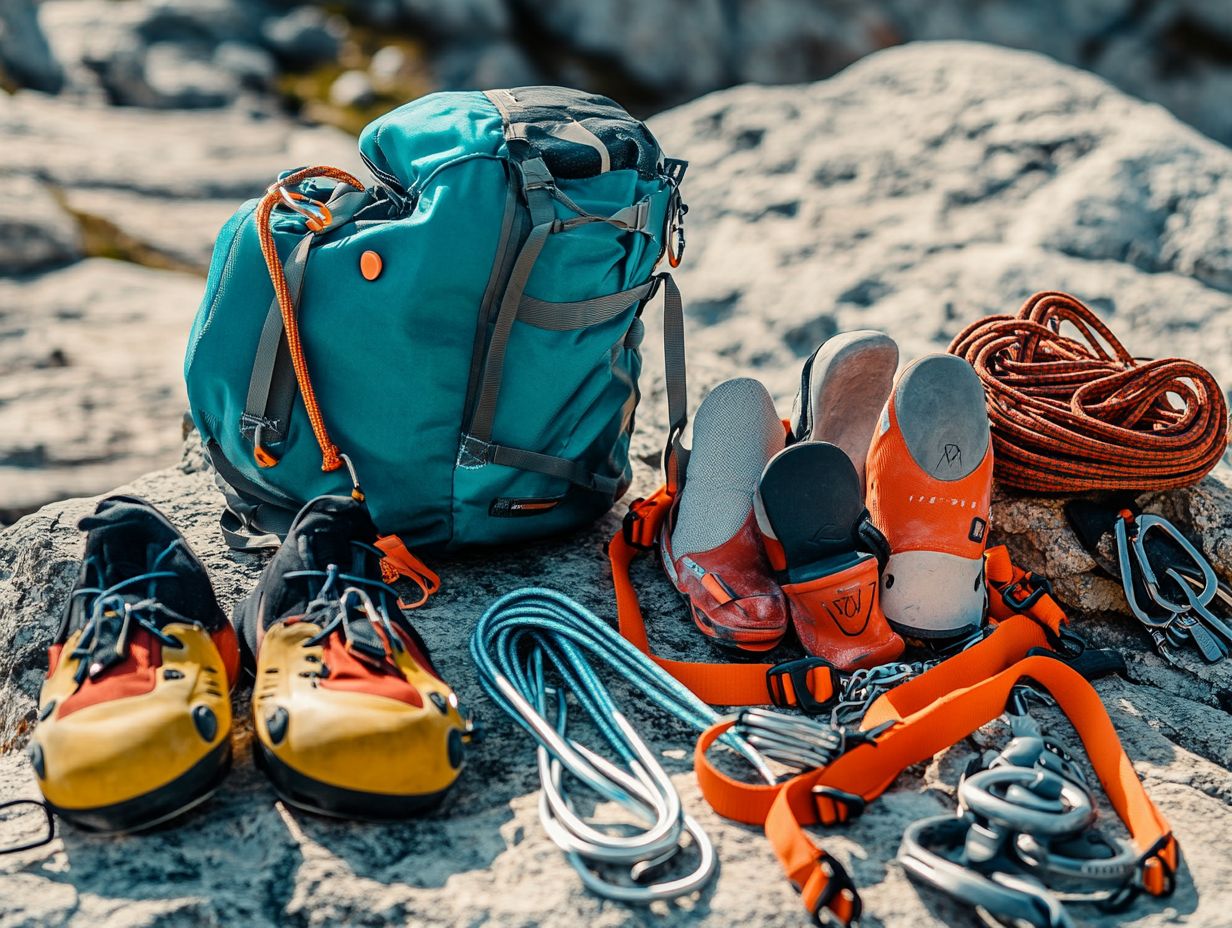
Belay devices are essential to your climbing safety, giving the power to your partner to manage the rope as you ascend and descend. These devices create resistance, allowing for controlled lowering and effective fall-catching. They are a must-have whether you’re just starting out or looking to refine your climbing techniques.
Familiarizing yourself with the different types of belay devices like tube-style, assisted-braking, and figure-eight can greatly enhance your safety and efficiency on the rock face. Each type offers unique functions tailored for various climbing scenarios, helping you manage dynamic forces during a fall more effectively.
For instance, assisted-braking devices automatically pinch the rope when they sense sudden force, adding an extra layer of security that can be a lifesaver on tough routes. By mastering best practices in using these devices, such as proper loading and maintaining a firm grip, you can significantly boost your confidence and ease while climbing, making the entire experience more enjoyable for you and your partner.
Helmet
Climbing helmets are critical for your safety while scaling heights, protecting your head from potential hazards whether you’re navigating the confines of a climbing gym or tackling rugged outdoor terrains. A properly fitted helmet isn’t just an accessory; it’s a crucial element of your climbing gear that can prevent serious injuries, regardless of your skill level.
Helmets have features for comfort and safety. These include impact-resistant materials, adjustable straps, and ventilation systems. Choosing a climbing helmet that fits snugly yet comfortably minimizes the chance of movement during falls, ensuring you get maximum protection when it matters most.
As you select a helmet, consider its weight, style, and certification standards; these factors play a direct role in your overall safety. With the unique risks associated with falling rocks and unexpected collisions, investing in a quality helmet can significantly reduce these dangers, allowing you to focus on the thrill of your climbing adventures with peace of mind.
Choose wisely and gear up for your next adventure with confidence!
Additional Gear for Advanced Climbing
As you transition from a beginner to a more advanced climber, additional gear like climbing tape and a nut tool becomes critical for tackling challenging routes and enhancing your climbing experience.
Essential items such as ropes, quickdraws, climbing protection, and various accessories are about more than just safety; they open the door to advanced climbing techniques. For those starting out, having the right equipment, including essential hiking gear for beginners, will enhance your safety and enrich your skills and confidence on the rock.
Ropes
Ropes are a vital part of your climbing gear, acting as your lifeline during ascents and descents. The type, length, and diameter of the rope you choose greatly impact your safety and climbing ability.
Dynamic ropes stretch under load, absorbing fall energy, while static ropes are inelastic and ideal for activities like rappelling and hauling gear. For example, in sport climbing, a dynamic rope cushions falls, ensuring your safety. Conversely, when setting up a top rope or conducting rescue operations, a static rope provides the stability needed for secure anchors.
When selecting the right climbing rope, consider the type of climbing you ll do, how often you ll use it, and its weight capacity. Proper maintenance is key to ensuring your rope’s longevity and reliability. Remember to regularly check for wear, clean it when necessary, and store it safely. Selecting the appropriate gear for outdoor climbing is essential.
Quickdraws
Quickdraws are critical tools in your climbing kit, connecting your rope to anchors and enhancing your safety and fluidity during ascents. Mastering quickdraw usage is vital for climbers looking to refine their skills.
These handy devices consist of two carabiners linked by a strong sling, each serving an important function. The top carabiner attaches to the anchor or bolt, while the bottom one is for clipping the climbing rope. This setup minimizes rope drag, keeping you anchored while efficiently managing falls.
It’s essential to get familiar with the various types of quickdraws. For instance, sport quickdraws are designed for shorter routes and tend to be lightweight, while alpine quickdraws are built to endure rugged conditions and cover longer distances. Understanding these distinctions enhances your safety and performance across climbing styles, from sport to trad and even bouldering.
Climbing Protection
Climbing protection includes the gear and techniques you use to secure yourself as you ascend, ensuring safety in case of a fall. Familiarizing yourself with various types of protection like cams (devices that expand to fit into rock cracks) and nuts can significantly improve your climbing experience, especially outdoors.
These tools come in different designs, each suited for specific situations and rock types. For example, passive protection like nuts can be placed in cracks, offering solid support without mechanical parts, while spring-loaded camming devices (cams) provide flexible placement options thanks to their expandable design.
The importance of this equipment cannot be overstated; it not only helps prevent injuries but also boosts your confidence as a climber. Proper placement requires assessing the rock s surface to ensure your gear is securely anchored, while effective removal involves technique and sometimes using a quickdraw. Mastering these skills can truly enhance your safety and success on the rock.
Have you ever wondered which gear is essential for your climbing adventures? Embrace the equipment and get ready for thrilling experiences ahead!
Other Accessories
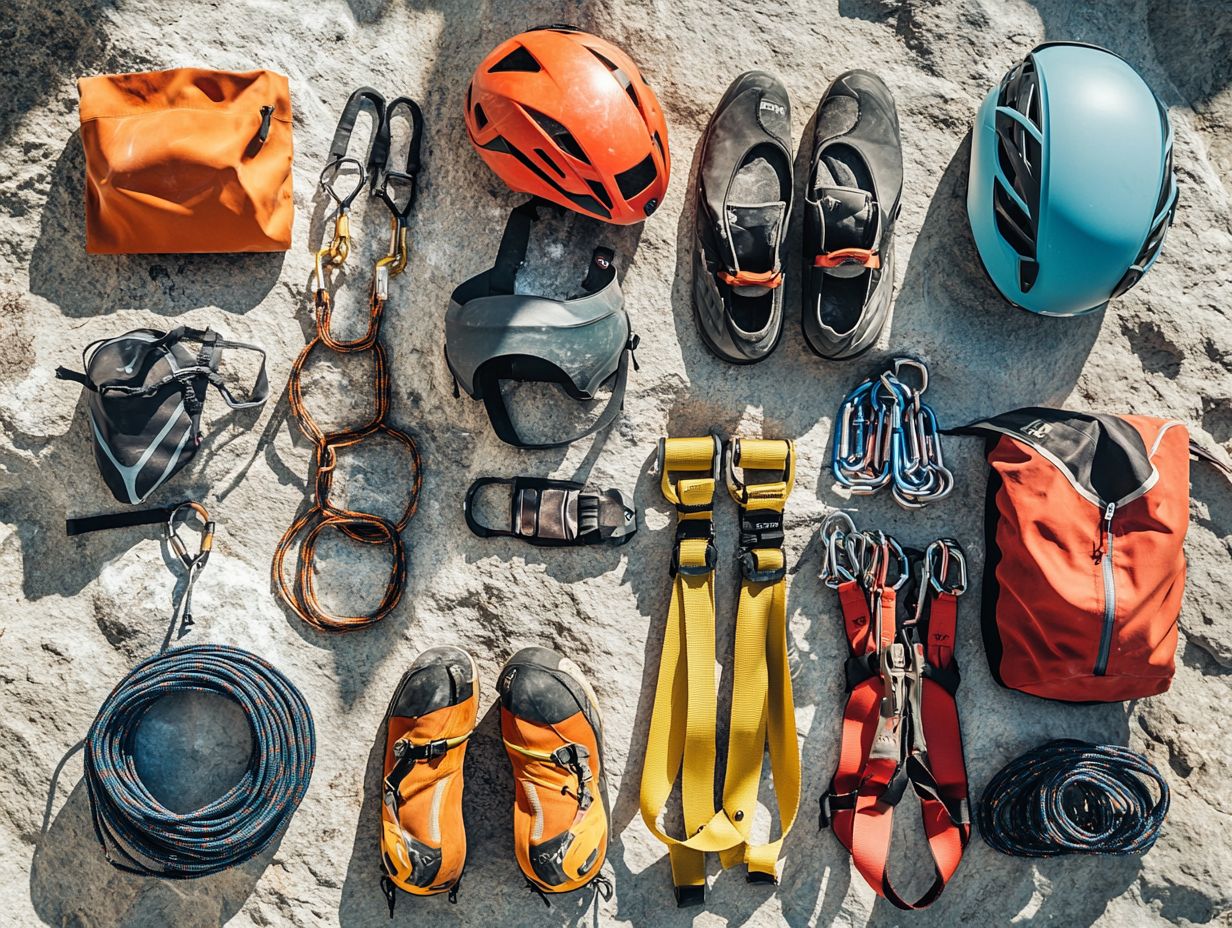
Climbing accessories, like tape and brushes, are essential for your gear. They enhance safety and improve your overall climbing experience.
Chalk bags and quickdraws are also vital. Chalk keeps your hands dry, while quickdraws help with clipping into protection during climbs.
Maintaining your gear is crucial. Regular checks and cleaning ensure your accessories perform well and last longer.
Understanding your gear s roles and maintenance can elevate your skills. This knowledge boosts your confidence on the rock face.
Factors to Consider When Choosing Gear
When choosing climbing gear, several essential factors significantly impact your safety and performance. Fit and comfort are of utmost importance; after all, ill-fitting equipment can lead to discomfort and hinder your movement.
Consider price, brand, and quality carefully. Reliable gear will endure through countless climbs.
Fit and Comfort
Fit and comfort are paramount when it comes to climbing gear, as they significantly impact your ability to perform and truly relish the experience.
A well-fitted harness enhances safety and provides the essential support you need, much like choosing quality climbing shoes. Climbing shoes should offer a snug fit for optimal performance.
When selecting your climbing gear, it s essential to consider not just the sizing but also how each piece interacts with your body movements.
Look for harnesses that distribute weight evenly and avoid pressure points. Additionally, consider how your climbing pack is structured for optimal weight distribution.
Trying on climbing shoes in-store is a smart move. It helps you find the right balance between tightness and comfort while allowing you to evaluate the sole rigidity for those crucial footholds.
Different climbing styles may call for specific gear features. Testing items during basic climbing activities can provide you with a practical sense of fit and functionality.
Remember, only through hands-on experience can you truly determine whether the gear aligns with your personal preferences and elevates your overall climbing adventure.
Price
Price is a major factor when you’re in the market for climbing gear. It can fluctuate dramatically based on the brand, quality, and type of equipment.
While high-quality gear might seem like a steep investment at first, it often pays dividends in terms of durability and performance.
Establish a budget that reflects your climbing needs and how often you plan to use the gear. Entry-level gear usually falls within the $50 to $150 range, while advanced options can easily exceed $500.
It s vital to assess whether the higher price point genuinely translates to improved safety features, superior materials, and a reputable brand.
Diving into reviews and asking for recommendations from seasoned climbers can be incredibly helpful in finding the best value for your investment.
Additionally, keeping an eye out for seasonal sales and exploring second-hand markets can help you maximize your budget without compromising on quality.
Brand and Quality
The brand and quality of your climbing gear significantly shape your experience. Opting for reputable brands like La Sportiva, Petzl, Black Diamond, and Arc’teryx ensures you’re using reliable, high-quality products. Choosing gear from trusted manufacturers enhances your safety and performance, making it a pivotal aspect of your climbing journey.
When faced with many choices, take the time to explore your options and research the reputations of various brands. Trustworthy brands focus on innovative technology, durability, and comfort essential elements for conquering challenging terrains.
You will likely find yourself leaning toward specific brands that have consistently met your needs, cultivating a sense of loyalty. In this dynamic market filled with choices, diving into product reviews and seeking insights from seasoned climbers can greatly aid you in making informed decisions. This ensures that each adventure is as safe and rewarding as possible.
Frequently Asked Questions
What is the most important piece of gear for beginners when starting to climb?
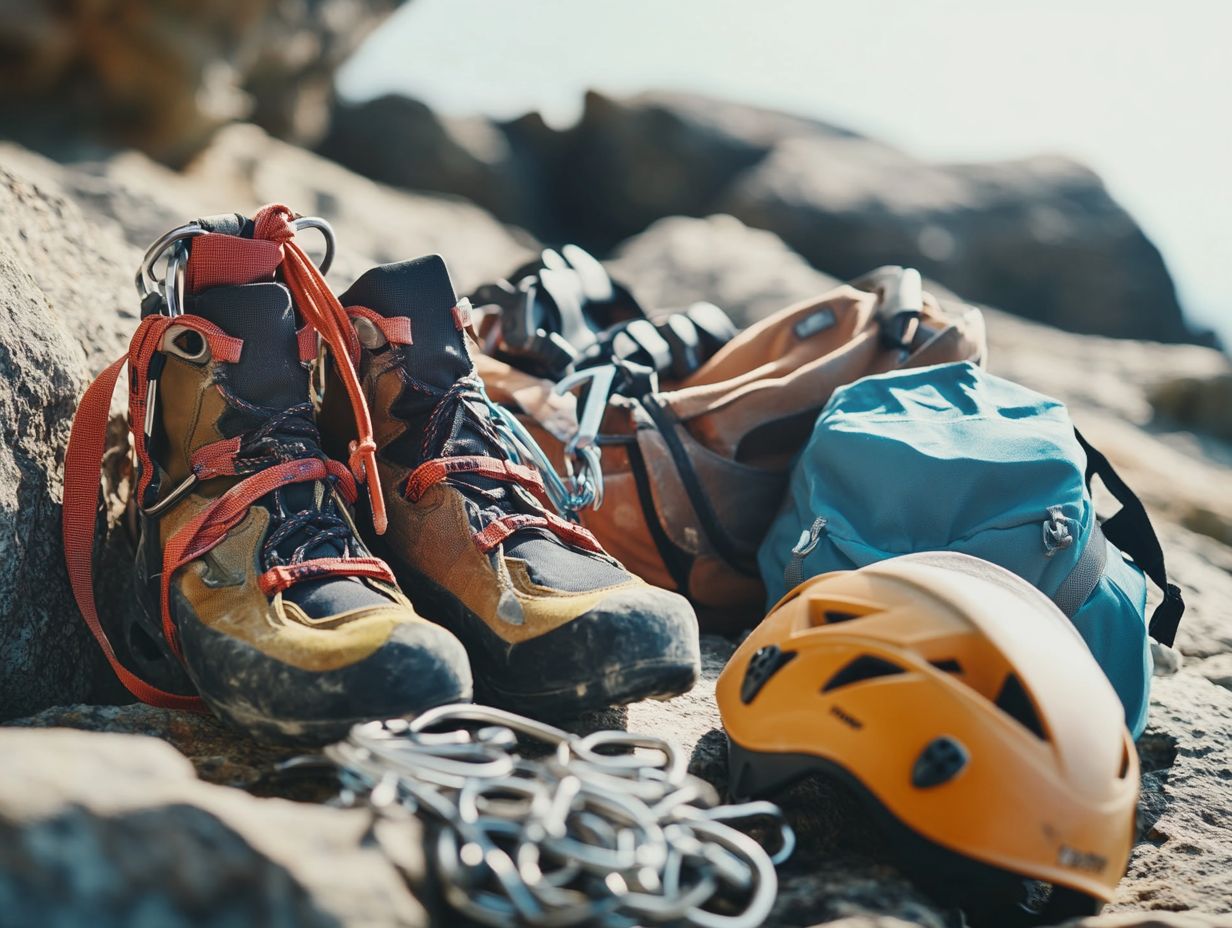
The most important piece of gear for beginners is a properly fitted pair of climbing shoes for grip and support.
What type of harness should beginners use for climbing?
Beginners should use a basic, well-padded harness that fits comfortably.
Is a helmet necessary for beginner climbers?
Yes, a helmet is essential for protecting your head while climbing.
What type of rope should beginners use when climbing?
A dynamic rope is best for beginners as it stretches to absorb falls.
How should beginners choose the right climbing shoes?
Choose climbing shoes that fit well and offer the right grip for your climbing type.
What other essential gear should beginners have when starting to climb?
In addition to shoes, harness, and helmet, beginners should have a chalk bag, carabiners, a belay device, and climbing pants.

